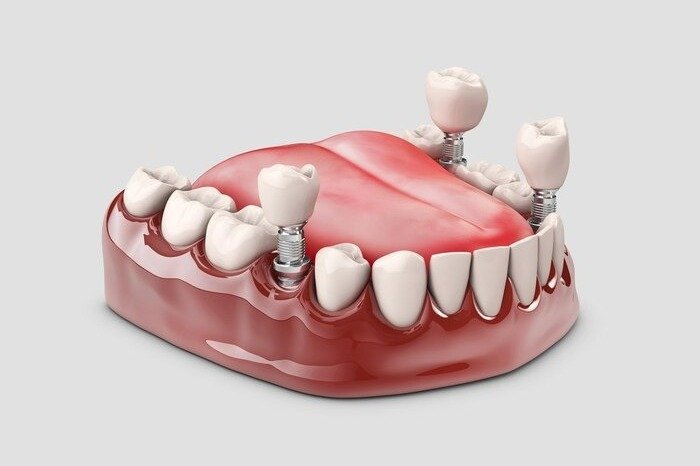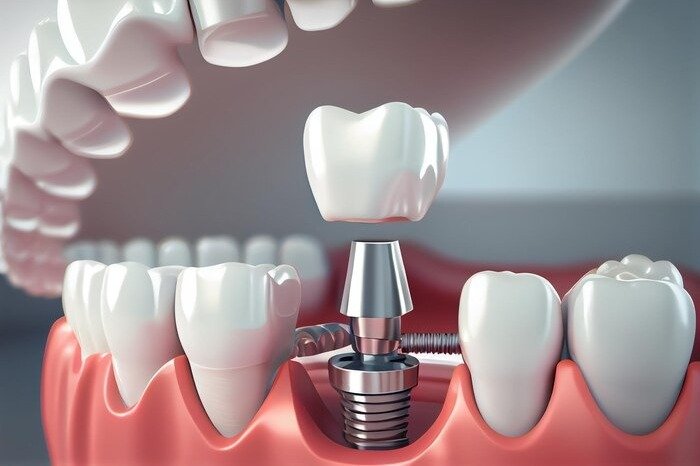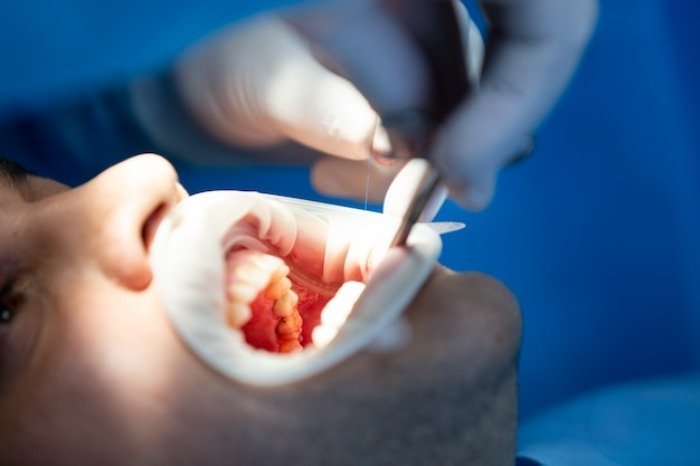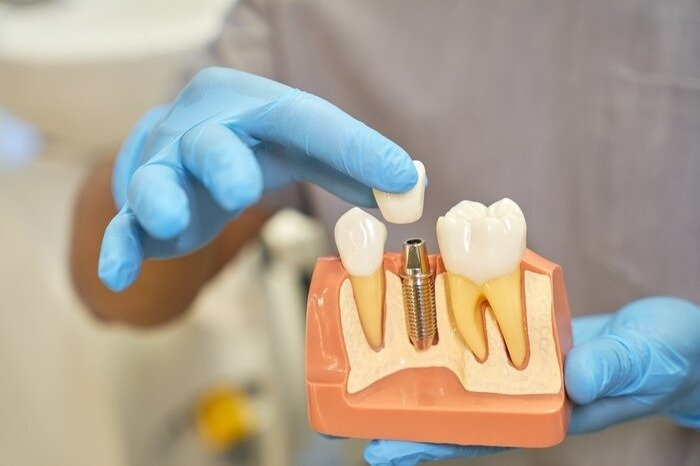ImplantEverything you need to know about immediate dental implants
ImplantationDental implantsare considered one of the best and most advanced methods for replacing lost teeth. However, many people refrain from this advanced and effective method for various reasons, including fear of surgery. This fear may discourage an individual from undergoing implant placement, which is actually a necessary medical need, and delay treatment. To tackle this issue,immediate implantdental treatment can be a suitable choice; a method that we will discuss all important details about in this section of health and wellnessSelMagz.

What is immediate dental implant?
The immediate dental implant, known in English as immediate implants or digital implant and non-surgical implant, is an innovative and minimally invasive method for dental implantation that eliminates the need for gum incisions and consequently stitches. In this method, the implant is placed using a faster technique, resulting in minimal bleeding and pain, becoming a suitable and natural replacement for lost teeth. This method is particularly used when the gum and bone tissue of the individual are sufficiently healthy and robust, as the material of the immediate implant is titanium and sometimes its derivatives, which is positioned within the jaw as the base of the tooth.
With this method, the dentist has more precision in placing the implant and prevents damage to the surrounding gum and bone tissues with minimal interference.Tooth extractionand immediate implant, as mentioned, speed up the healing and integration process with the bone, thereby minimizing the patient’s recovery time.

Types of immediate dental implants (Digital implants)
Immediate dental implants are generally divided into two main categories:
Immediate anterior dental implants (Immediate Loading Implants)
This type of immediate implant is suitable for front teeth, which, due to their position and visibility, hold significant importance for facial aesthetics. In this method, the implants are quickly positioned after the surgery, and artificial teeth (bridge, prosthesis) are installed either temporarily or permanently on the implants. This method allows patients to use their new teeth immediately after the surgery.
Immediate dental implants for jaw (Fresh Socket Implants)
In this type of immediate implant, typically an implant is quickly placed in the empty socket following the removal of a damaged tooth. This method helps patients quickly access their new and natural implant teeth after extraction. It is specially used in cases where teeth need to be extracted and immediate replacement is necessary.



Procedure for immediate dental implant
To familiarize yourself with this method, you can watch the immediate dental implant video available onsocial mediawhich illustrates the general steps for immediate dental implantation:
Initial examination by a dental specialist
First, you must visit an implant specialist so that they can assess the status of your mouth and jawbone. This stage includes a clinical examination, taking radiographic images, and establishing a treatment plan. Then, the doctor will prepare a more precise plan for your immediate dental implant. This involves determining the number and position of the implants, designing a temporary prosthesis, and planning the surgery.
Surgery
After planning, during the surgery stage, holes are created in the gum for the placement of the implants. The implants are then carefully positioned using surgical techniques. After the implants are placed, a temporary prosthesis is attached to them.
Delivery of temporary prosthesis
The temporary dental prosthesis is connected to the implants after the surgery. This temporary prosthesis allows you to eat and use your mouth until the bone integrates with the implants.
Post-surgery check-ups
After the surgery, your doctor may schedule several visits to assess the condition and progress of the restorations. These visits help in adjusting and better fitting the final prosthesis.
Delivery of permanent prosthesis
After the bone integrates with the implants and the final restorations are completed, the permanent dental prosthesis is delivered to you. This prosthesis is precisely positioned on the implants, allowing you to benefit from your new, more natural teeth.
Difference between immediate and regular implants
The differences between digital and conventional implants are as follows:
Level of pain and discomfort
In traditional surgical implant placement, you may encounter gum cuts, bleeding, and pain. However, in immediate dental implants, through digital dental implants and using specialized devices, the process is completed without incisions and with minimal pain and bleeding.
Time of completion
In immediate dental implant surgeries, the implant is placed immediately after the extraction of damaged teeth, whereas in traditional surgical methods, you undergo multiple steps which can be time-consuming.
Cost


The cost of immediate dental implants is generally higher than that of traditional surgical implants. This increased cost is due to the use of more advanced technologies and the faster process of immediate dental implants.
Compatibility with tissue
Immediate dental implants are usually performed using three-dimensional information and a more accurate surgical guide, resulting in better tissue compatibility and greater precision in implant placement.
Recovery time
Due to minimal damage to the surrounding tissues, the healing process with immediate dental implants occurs more rapidly, leading to a faster recovery for the patient.
Durability
With the rapid method, immediate dental implants tend to be closer to the durability of permanent implants.

Why immediate anterior dental implants are important
Immediate anterior dental implants are significant due to the visibility and position of front teeth, and the reasons for the importance of anterior dental implants can be explained as follows:
Impact on facial aesthetics
Front teeth are very important for appearance and greatly affect facial beauty. Any defect in these teeth can affect the entire appearance of the face. Therefore, immediate anterior dental implants help patients quickly obtain more beautiful and natural-looking teeth.
Impact on speech ability
Front teeth play a crucial role in pronunciation and speech. Any problem with these teeth may cause difficulties in articulation and speaking, which can affect the individual’s ability to communicate. Using immediate anterior dental implants can quickly resolve these issues, allowing the patient to speak correctly in everyday interactions.
Increased self-confidence


Front teeth play an important role in enhancing the morale andself-confidenceof individuals. The absence of front teeth can psychologically harm patients. Immediate anterior dental implants can resolve the issue of low self-confidence caused by missing teeth.
Advantages of immediate dental implants
Immediate dental implants offer numerous benefits that contribute to the popularity of this treatment method, including:
Reduced implant placement time
This method significantly reduces the time required for implant placement due to the use of advanced technologies, allowing patients to access new teeth more quickly.
Suitable for special cases
Immediate dental implants provide a suitable solution for individuals who are unable to undergo conventional implant placement due to surgical limitations.
Reduced pain and swelling
This method significantly reduces the level of pain and swelling after surgery.

Suitable for diabetics and smokers
Immediate dental implants also provide a suitable option for diabetics and smokers, allowing these individuals to improve their dental conditions.
Immediate delivery of temporary crown
Immediately after the placement of immediate dental implants, patients can use a temporary crown for their teeth and access beautiful new teeth during the same treatment session.
Suitable for special cases
This method enables individuals who have suffered from dentures or edentulism for a long time to return to natural teeth in just one session.
Reduction of gum and bone recession


Immediate dental implants prevent gum and jawbone recession, which reduces pain and bleeding associated with implant placement.
Placement of multiple implants in one session
Due to the high speed of digital immediate implants, multiple implants may be placed in one session.
Disadvantages and side effects of immediate implants
However, the disadvantages of digital dental implants are as follows:
Limitations in bone and gum conditions
Immediate dental implants are suitable for individuals with healthy jawbone and gums. If the jawbone has significant damage or the gums are not sufficiently healthy, immediate implants may not be appropriate.
Improper temporary prosthesis
If the temporary prosthesis is not placed correctly and on time, it can lead to the failure of the implant. This temporary prosthesis must be properly connected to the implant to ensure proper integration and bonding with the jawbone.
Risk of infection
If the implant does not bond with the jawbone, the risk of gum infection and infection in the tissues surrounding the implant increases.
Limitations in complex cases
Immediate dental implants are not the most suitable solution for cases that require new and complex restorations or multi-stage implants.
Pressure on tissues
In some cases, choosing immediate implants may put excessive pressure on gum and bone tissues, potentially leading to issues in the long term.
Limitations in tooth size and shape
Immediate dental implants may not be suitable for cases that require restoration of teeth with specific shapes or sizes, potentially causing aesthetic issues for the new teeth.

Cost and price of immediate implants


In fact, the cost of digital immediate dental implants depends on various factors, including:
Type of implant
Different types of implants with varying qualities and characteristics are available in the market. The brand, model, and specifications of the implant can significantly affect the price.
Level of specialist expertise
The experience and expertise of the dental surgeon performing the implant placement play a significant role in determining the price. Experienced and highly specialized doctors may charge higher fees.
Bone graft costs
In some cases, a bone graft may be necessary before implant placement, which can increase the overall cost.
Number of implants
The number of implants that need to be placed naturally affects the price.
Consumables and equipment
The consumables used for implant placement and other equipment can also impact the overall cost.
Durability of immediate implants
Immediate dental implants, like conventional implants, can remain in the mouth for a very long time if proper care and maintenance are taken. The longevity of implants depends on various factors including:
Oral care and hygiene
Thorough oral care for the mouth and the implants, including regular brushing, flossing, and using mouthwash, enhances the longevity of the implants.
Proper diet
Maintaining a proper diet and avoiding hard and unsuitable foods for the teeth can help preserve the implants.
Health of gums and surrounding tissues
Maintaining the health of the gums and the tissues surrounding the implants is essential. Not suffering from gum infections and not having oral problems can significantly influence the lifespan of the implants.
Regular visits to the dentist
Regular check-ups and assessments to monitor the condition of the implants and ensure no issues arise can help increase their longevity.







